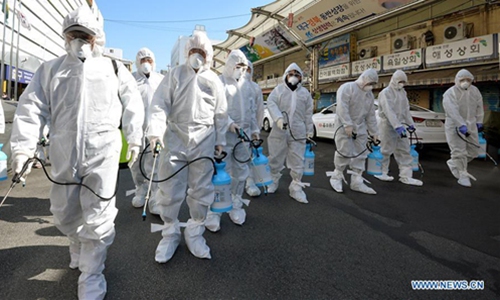HOME >> OPINION
Virus-hit countries should take no chances
Source:Global Times Published: 2020/2/24 23:48:41

Staff members disinfect a market in Daegu, South Korea, February 23, 2020. As of Monday evening, 833 infected cases have been confirmed in South Korea, with eight deaths. (NEWSIS/Handout via Xinhua)
The novel coronavirus pneumonia (COVID-19) epidemic is spreading in countries like South Korea at a surprising rate. As of press time, 833 infected cases have been confirmed in South Korea, with eight deaths; the number of confirmed cases in Italy climbed to 219, with five deaths; and Iran's COVID-19 death toll jumped to 12.In South Korea, where the epidemic is severest outside of China, most of the infected people are from Daegu and North Gyeongsang province, however the authorities still seem to pin all their hopes on the epidemic being local. However, South Korea covers a total area of 100,000 square kilometers with an estimated population of 51 million. From China's experience battling the COVID-19, it makes limited sense for South Korea to separate infected areas from non-infected ones.
South Korea has a well-developed traffic system. It takes three hours to drive from Daegu to Seoul. On Saturday, many churchgoers at the Shincheonji Church of Jesus, where South Korea's epicenter of COVID-19 is, gathered in Seoul to support the opposition party and protest against the current government. As of press time, Daegu is still accessible from all other areas of the country. Although the South Korean government has paused mass activities and postponed the new semester, the measures may still be insufficient in dealing with the outbreak.
Long-distance transportation is still running in South Korea. In the subways of Seoul and Busan, commuters are still crowded together. This is a worrisome scene.
We need to remind South Korea and other countries with severe epidemic: Do not be deceived by the current small proportion of infected cases or believe the infection rate is low. As confirmed cases increase, panic could spread to the whole society. At that time, if the government is not capable of controlling the situation, social order could possibly collapse. As long as the epidemic worsens, every day could be a totally different situation.
As the COVID-19 spreads too fast and has a relatively long incubation period, it is dangerous for a government to prepare only based on the current situation. Prevention and control measures should consider what can be the worst situation in the following 10 to 20 days.
Those countries with a severe epidemic could be a greater threat to the world than China in transmitting the virus internationally. Although there are still many new confirmed cases in China's Hubei, the province is totally locked down, while other places in China have general taken the epidemic under control. It becomes increasingly impossible for Chinese to be infected outside of Hubei.
In contrast, the epidemic is still growing in countries like South Korea, and local authorities don't have a clear idea of how the situation is.
These countries have not yet started developing an emergency prevention and control network for their society. Their societies have not yet mobilized. Italy has locked down some severely affected towns in the north, but not many people are involved.
Relevant countries should not repeat the mistake of Wuhan and regret later that they should have taken action earlier. If an outbreak cannot be effectively controlled in Italy, European countries nearby will highly likely be impacted.
The 2003 SARS outbreak peaked in March and April. This means the real risk for Europe may just be starting. It is hoped this won't become a real situation.
In the face of the COVID-19, all human beings are a community with a shared future. And we should work together to win this battle.
Posted in: EDITORIAL